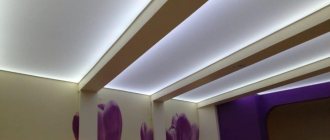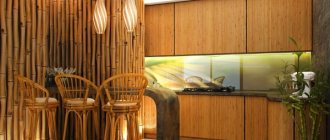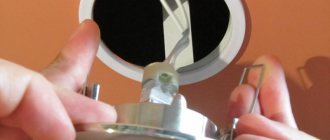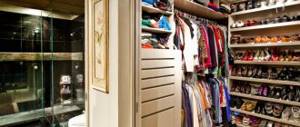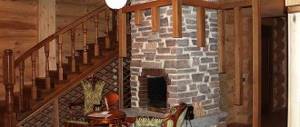Automatic lighting
Lighting of staircase structures is most often necessary only when a person moves along it.
The exception is the emergency lighting of the stairs, which, when switched on, is constantly on. To solve the problem of saving electricity, without sacrificing safety and comfort, automatic systems for turning on and off lights on staircase structures are often used. The video in this article will clearly demonstrate the operation of such machines.
Automatic systems are programmed for the level of general illumination of the room and come into operation when staircase lighting becomes necessary.
Staircase lighting scheme
Automatic staircase lighting is provided using special sensors that respond to movement or sound. Such a system can also be controlled using a remote control.
Motion sensors
Built-in motion sensors for staircase lighting turn on the light on the staircase system when a moving object appears within a certain range of the room. Stopping movement helps turn off the light sources after a certain period of time.
Noise sensors
Automatic acoustic systems respond to the noise level in the room. Staircase lighting in an apartment building is often performed using just such devices.
Sound sensor on stairs
Automatic lighting control systems not only help save energy, but also provide convenience for going up and down stairs, since there is no need to search for a switch in a dark room.
The price of such systems can be quite high. But their cost will quickly pay off due to the saved costs on paying electricity bills. Manufacturers' instructions advise protecting automatic sensors from voltage surges.
Other types of staircase lighting controls
You can control the staircase lighting in other ways:
- Radio controlled switches can be less expensive. They do not require electrical wiring, which is very convenient when installing them in finished rooms. Such a system consists of the switch itself and radio signal receivers. The first element is fixed on the wall or fence. Receivers are installed on lighting fixtures. The range of these systems may vary. The disadvantage is the periodic replacement of batteries.
- You can also install keys with a timer on the switches. They are programmed for a certain period of time during which the staircase structure is illuminated. Then the light turns off automatically.
- Automatic lighting of staircase steps sequentially turns on the illumination of each step as you move along the staircase structure. Motion sensors are installed in front of the first and last steps of the stairs. The backlight turns on automatically when you cross its coverage area. You can configure the staircase lighting controller with specified parameters for the number of steps, light brightness, and speed of turning the lighting on and off.
If you want to make automatic staircase lighting, then the choice of devices for this is currently quite diverse.
Light Source Control
The lighting design of the staircase system significantly affects traffic safety and creates its unique appearance.
Night staircase design
The answer to the question: how to make staircase lighting, everyone chooses depending on their individual design and taste. The variety of interior solutions that can be achieved using lighting structures will satisfy any needs. The main thing is not to forget about safety. And then the staircase will become a decoration of the whole house.
Features of lighting of external stairs
If changes in temperature, humidity and other atmospheric influences are not particularly important for organizing the lighting of internal staircases, then external structures have their own characteristics.
- The power of outdoor light sources should be greater than that of indoor lamps.
- In the case of using general lanterns to illuminate the courtyard and stairs, their location should provide enough light for the entire system.
- Only lighting fixtures specifically designed for outdoor installation should be used. Lamps for lighting the stairs in them must be protected from atmospheric influences, that is, covered with shades.
- Electrical wiring is used with reinforced insulation that can withstand temperature changes and precipitation.
Original options
Lamps can be located:
- On the walls of the house;
- On the fence;
- Suspended from cables;
- Installed on poles.
Low columnar lighting structures are often used.
https://youtube.com/watch?v=CMlPUekL1S8
Primary requirements
Types and features of escape stairs
The lighting scheme may include only one type of lighting fixtures, or a whole combination of fixtures.
How to do
In any case, there are basic requirements that must be met:
- Safety and traffic comfort are the main requirements that the entire lighting system must fulfill. It is necessary that both the entire structure and its individual elements are well illuminated.
- Illumination should be uniform.
- The light source should not blind a person's eyes.
The selection of lighting devices must be based on:
- General level of illumination in the room;
- Lamp power;
- Directions of the light beam at the light source.
Compliance with basic safety measures will help avoid injuries during use and make movement around it more convenient.
Daylight
The lamps used must be safe and easy to use.
Spiral staircases
In small rooms it is often impossible to use a full-fledged marching structure. It would be advisable to install a spiral staircase here. It is more compact. If desired, it can be placed on an area of 1.5 square meters.
The steps in such a staircase are fixed in a spiral, according to the principle of a screw thread. This is what the name is connected with. Screw structures have a number of disadvantages. However, it is very simple to equip lighting for such a staircase. You can mount lighting fixtures on one axial stand. Such a lighting system can be organized after the staircase has been installed.
Working methods
Polish chandeliers
Original lighting can be done in 2 ways. One is from the switch; for comfort, you can install switches at the bottom of the stairs and at the top.
It will be more economical. Connecting an intelligent circuit is more efficient. It is necessary to install sensors on the bottom step and the top.
If a person steps on the stairs, the controller will immediately receive a signal and launch the light elements.
The second method is more used in basements. When the door opens, the sound will be detected by the sensor and the backlight will turn on.
Another motion sensor will turn on the lights when a person approaches the stairs. This is a great energy saving. To prevent the sensor from reacting during the day, a photocell is installed - this is a “smart lighting system”.
Lighting with lamps
Staircase lighting should be good. At the same time, it is not very bright, so as not to dazzle, and is convenient to use. If your staircase connects to a wall, you can use wall lights or sconces to illuminate it.
They will not only serve as lighting for the staircase, but also decorate your wall. They will also add more comfort to the atmosphere of your home. You can also use hanging light sources. If selected correctly, they will not spoil the interior of the room at all.
Lamps are:
- External.
- Built into the steps.
- Built into balusters or railings.
The lamps can be installed independently. But if you do not have experience with electricity, it is better not to take risks, but to seek the help of specialists.
Staircase lighting in a house can be done using neon, halogen, or LED light sources.
LED backlight softness, smoothness, benefit
The light source in this type of lighting is LED strip. The light it emits is soft tones - amber, turquoise, white. It is very easy to choose lighting of the color that you like, and which, even in semi-darkness, harmonizes with the interior.
There is no need to worry that LED staircase lighting will dramatically increase your electricity bills: it consumes 20 times less energy than a traditional incandescent light bulb. Moreover: during the day, when there is enough natural light, the system turns off - the light sensor protects you from unnecessary expenses.
By the way, the LED lighting for the stairs is customizable, which makes it convenient for you and your family. There are enough opportunities. Thus, you can adjust the speed at which the stage lighting turns on and its duration. If you like, the staircase can be fully illuminated as you approach, or the steps can be turned on in groups (this is especially convenient if the flight of stairs is long).
In principle, the possibilities begin when you purchase the system. If you know a little about electrical engineering, you can install it yourself - it's easy. If electricity is something you don’t understand, you can order the installation of a turnkey system, and the company’s specialists will equip your staircase with lighting quickly, efficiently, and even with a guarantee. You also don’t have to worry if your staircase has special features: automatic lighting is installed on staircase structures of different types. Dimensions are also not important: you can choose a kit for lighting a staircase with up to 16 steps, or a kit for a large staircase (24 steps).
And, of course, there is no need to worry that when washing the steps, water will seep into the LED strip: it is securely packaged in a silicone shell.
By equipping your staircase with lighting, you gain a lot. First, you get rid of the tension that arose every time you had to go up or down numerous steps in the dark. Secondly, your interior ceases to be static, it comes to life and changes, becoming spectacular. And all this gives you peace and pleasure. Moreover, every day, for many years (at least ten - according to the service life of the backlight system). Is it possible to refuse this?
Lighting the stairs in the house how to control the lamps
We are all accustomed to standard lighting control using conventional key switches. It is relatively convenient, practical and, most importantly, not very expensive. The only “but” in this method of controlling light on the stairs is that it is one-sided - in the sense that a regular switch can only be placed at the top or bottom of the flight of stairs. The inconveniences of using them are very obvious - once you turn on the light at the top of the stairs, you can’t turn it off at the bottom. It is for this reason that on flights of stairs, light control is performed using other types of switches.
- Pass-through switch. This device works in pairs - one key is installed at the top, and the second at the bottom of the stairs. Both buttons work independently of each other and can independently turn the light on and off, regardless of the position in which each of them is located. The thing is very convenient. By the way, like ordinary ones, pass-through switches can be one- or two-key (there are even three-key), touch and mechanical, with or without backlight. In general, the choice is very rich. So if there are three groups of lighting on your flight of stairs, then it is quite possible to control them using two- or three-key pass-through switches.
- Staircase lighting with motion sensor. This method of controlling the lighting on the stairs does not require any human intervention at all - or rather, the person does not have to press anything. A special sensor that reacts to the presence of moving objects is responsible for turning the lighting devices on and off. When the motion sensor detects a person, it sends a command to the electronic key, which closes the lighting circuit - after the sensor stops detecting movement, the circuit opens and the light turns off. The delay time can be adjusted - that is, the lighting will turn off after a certain time from the moment the sensor stops detecting movement. As a rule, this method of controlling lighting on stairs uses a pair of sensors - one is mounted at the bottom and the other at the top of the flight of stairs.
By and large, setting up automatic control of lighting on the stairs with your own hands today is quite easy - there are quite a lot of different lighting devices on sale that already have a motion sensor. Such lighting fixtures can be connected like standard sockets, bypassing the switch, which is not very difficult to do with your own hands.
And in conclusion to the topic of what staircase lighting can be, I’ll say a few words about the concept of hidden lighting - this is when lighting fixtures are hidden, and they are either not visible at all, or they are noticeable when a person knows about their presence. It is standard practice to produce such lighting using LED strips, but there is another interesting option - fiber optic lamps. Its meaning is to transmit the light flux through an optical cable, which can have different thicknesses of fibers - that is, a light generator (projector) is mounted in a hidden place, from which thin fibers diverge to the right places, which can be released anywhere on the stairs. These fibers become a source of light only when light is supplied to them - if there is no light, then the fibers, due to their structure, are practically invisible.
Types of lamps for lighting stairs
In addition to incandescent lamps, which consume a lot of energy and produce a large amount of heat, the following are used for installing staircase lighting:
- Halogen. They shine brightly, but emit heat, so they are rarely installed in wooden structures. They are ineffective as additional lighting in combined systems, since bright light on stairs is usually not needed. Lack of sensitivity to voltage changes, which is why they quickly burn out.
- Neon lamps. They shine dimly and last a long time. The case is quite fragile, so protective devices against mechanical damage are needed.
- LEDs are the most popular, as they have a wide range of shapes, power, and colors. Suitable for installation near wooden structures because they do not emit heat. They last a long time.
Economical lamps can be used in large quantities, creating light panels and beams of light on various parts of the stairs.
Selection of lamps
When you are wondering which lamp to choose and which one is easier to install yourself, a huge assortment appears before you. Of the many varieties, halogen and LED lamps are best suited. We will advise you to use the LED system, since with its help you can make the lighting more colorful and beautiful. They are also much easier to install yourself, thanks to their simple design.
The main indicator of the quality of a lamp for this application is its strength and wear resistance. Manufacturers specializing in the production of lamps for stairs usually produce them in a durable housing, either metal or dense plastic. LED lamps are better suited than others; there are simply no breakable elements. Built-in ones must be shock-resistant, since someone could step on them and there is a risk of an object falling on them.
The intensity of the luminous flux should not only be within normal limits, but also fit harmoniously into the decor of your home. Brighter light has the effect of expanding space, and soft, dim light will add calmness and help you relax faster.
Different types of lighting in the house
When choosing lighting, you should also consider what your staircase is made of. The color design of the housing must be combined with the color of the materials, and the color of the emitted light must be harmonious with the environment. If recessed luminaires are installed in wood, their housing should not overheat too much, as elevated temperatures can cause a fire.
When making staircase lighting with your own hands, you can install both centralized and remote control. It is possible to supplement the lighting elements with a motion sensor, so they will turn on when necessary.
Centralized control involves installing a switch, or a group of switches. Some will include recessed lights, others will include general lighting. Or one button for all the lighting at once.
Summarize
Lighting the staircase of your home is a creative process, although it is quite simple, but it must be approached with understanding and complete seriousness. Only a properly lit stairwell will help make your life more comfortable, and getting up to the bedroom after a hard day at work will not be a torment for you, but the beginning of your relaxation.
By correctly placing lamps on the floor, railings, steps and walls, and harmoniously choosing their colors, you will make your staircase the highlight of your interior. The most important thing is to always remember that in this matter you are not limited by any standards, use your creativity and imagination, then you can achieve an excellent result.
Lamps for stairs
For a multi-level apartment or a multi-storey private house, the staircase is an important part of the interior. Many people strive to use it not only as a functional item, but also as a decorative structure.
Sometimes they try to highlight it using backlighting. They also take into account the fact that household members use the stairs at any time of the day, so lamps are an integral part of such a design.
Illumination will make moving around more comfortable and safe. Separate staircase lighting is very popular now.
Peculiarities
Staircase lights should be quite bright, but they should not be blinding. Their peculiarity is that they create soft diffused light, as well as a minimum of shadows.
To illuminate the stairs leading to the second floor, it is better to use spotlights, which must be positioned correctly. There should be a distance between them of no more than 1 m. The optimal distance is 50-70 cm. Such lamps should be located along the entire length of the span.
In a private house, not only spotlights, but also wall sconces are used to illuminate steps. Such lighting is very reliable, but usually the sconce shines very brightly
Therefore, it is important to select the required brightness level.
Floor spotlights can highlight a beautiful massive staircase in a cottage. They have an unusual design and are located vertically between the spans
This lighting looks very beautiful and romantic. Subdued light will become the highlight of your interior and will perfectly illuminate the steps.
Varieties
Manufacturers now offer many types of lamps for stairs. They allow you to improve lighting in the house and make passage through it safer at any time of the day. The following types of staircase lighting are distinguished.
LED
LED lamps are the most popular. Many people use them to illuminate the stairs. Moreover, in this case, both spotlights in the form of light bulbs and LED strips are used, which can easily be used to hang the stairs. LED lamps are quite durable, their service life is more than five years.
They are completely safe because they do not heat up at all during operation. These products can be battery operated or rechargeable. By replacing the battery, you can extend their service life.
Manufacturers are now making lamps with LEDs, which are also equipped with motion sensors. This is an excellent “smart” lighting that not only looks impressive, but is also very practical. It allows you to reduce energy consumption, since the light bulbs will only turn on when someone moves on the stairs. They are very convenient, since you won’t have to look for a switch on the walls with your hands in the dark for a long time. It will also be very easy for you to move up the stairs even when your hands are full.
These motion sensors are very easy to install. Very often, smart lamps are installed on steps in the place where you step with your feet. They are completely covered with aluminum mesh for protection.
They are very popular because they are very reliable and practical. Such products are usually made in the form of spotlights above the stairs. They can also be mounted on walls. The big advantage of such lamps is that you can choose any color of lighting. Moreover, it can be both warm and cold.
Such bulbs allow you to play with light, darkening or brightening one or another part of the staircase. They can also last a very long time and are completely safe for human health. This is a great energy saving option.
Lamps for stairs
Staircase lamps are a very important and functional element. They ensure safety when climbing in the dark. What types of lamps for stairs are there? How to choose the right devices and place them on the stairs? LED lights for illuminating steps in the house, as well as other stylish and practical lamp models.
Staircase on rails
This type of construction looks airy and weightless. The steps are fixed at just a couple of points. On one side on the wall, and on the other - on rails (special racks located between the steps).
These stairs have no risers. This is what makes them transparent. Such designs help to retain maximum natural light in the room. This quality is especially important for modern minimalist styles, in which the primary goal is to preserve free space.
Steps in stairs of this type can be made of any materials. The frame used to secure them is usually made of metal. In this case, lighting for the stairs to the second floor can be placed in the wall.
There are also other types of stairs that combine all the elements described above. For example, the transition between floors in a staircase of two flights may have, instead of a landing, several steps made according to the screw principle. The type of construction is determined by factors such as the size of the house and the style of the interior.
Lighting the stairs in the house, how to make it Instructions 100 photo examples
Lighting, which is mounted in the staircase, not only makes it a beautiful element of a modern interior, but also makes the steps safe in the dark.
However, in order for the lighting to perform all these functions, the backlight must be installed correctly.
How to organize staircase lighting?
There are different options for installing lamps on the stairs. First of all, they depend on the lighting device. So there are the following types of lighting for stairs:
- LED linear lamps,
- Neon lights,
- Hidden lighting.
Meanwhile, there are separate lamps that perform lighting functions. Such lighting devices include:
- Railing lighting or lamps mounted in the side elements of stairs,
- Lamps mounted on wall surfaces
- Pendant lamps.
When choosing how to decorate the staircase lighting, you must be guided by individual preferences, the design of the house and the expected effect.
Neon lighting has the advantage of maximum safety, long service life and soft light that is pleasing to the eye.
Spot halogen lamps have the advantage of uniform distribution of illumination, but you should not count on a long service life of such lamps.
The most convenient to use are LED lamps. Because they can work both from electricity and from batteries.
In addition, such lamps can be used for a long time without replacement, they are resistant to mechanical damage and they evenly illuminate the stairs.
Wireless backlight
Many owners of private houses today are interested in how to arrange staircase lighting. Photos of finished options raise many questions. For example, can the system be designed to operate on its own power sources?
The LED Stair-5 wireless staircase lighting system has gained great popularity among consumers. It includes two motion sensors, five lighting fixtures and instructions. The kit is tuned to a specific signal frequency, so it does not require additional adjustment. The modules operate using simple batteries. One set, using high-quality batteries, will last about a year of operation.
This staircase lighting has many advantages:
- There are no energy costs.
- You can use the lighting even if the house is disconnected from the power supply system.
- Thanks to the presence of light sensors, the backlight will turn on only at night. This helps to achieve economical battery consumption.
- To install such a system, you do not have to cut walls.
- Anyone can install the kit. This does not require special skills. The lamps can be fixed either directly on the steps themselves or using double-sided tape on the wall.

